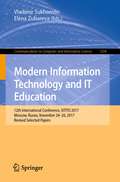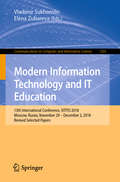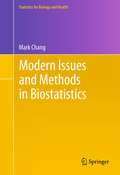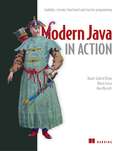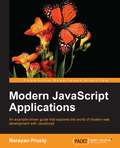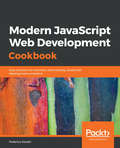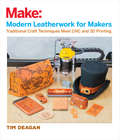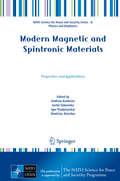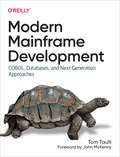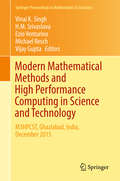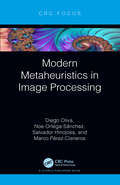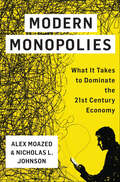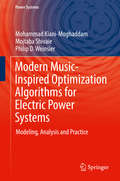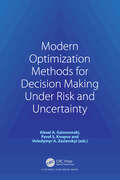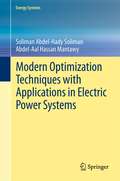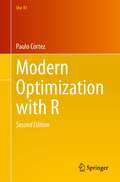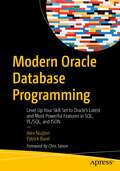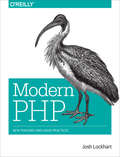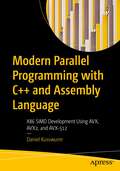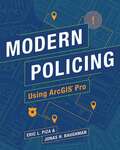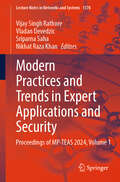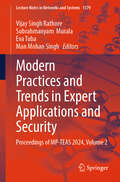- Table View
- List View
Modern Information Technology and IT Education: 12th International Conference, SITITO 2017, Moscow, Russia, November 24–26, 2017, Revised Selected Papers (Communications in Computer and Information Science #1204)
by Vladimir Sukhomlin Elena ZubarevaThis book constitutes the refereed proceedings of the 12th International Conference on Modern Information Technology and IT Education, held in Moscow, Russia, in November 2017. The 30 papers presented were carefully reviewed and selected from 126 submissions. The papers are organized according to the following topics: IT-education: methodology, methodological support; e-learning and IT in education; educational resources and best practices of IT-education; research and development in the field of new IT and their applications; scientific software in education and science; school education in computer science and ICT; economic informatics.
Modern Information Technology and IT Education: 13th International Conference, SITITO 2018, Moscow, Russia, November 29 – December 2, 2018, Revised Selected Papers (Communications in Computer and Information Science #1201)
by Vladimir Sukhomlin Elena ZubarevaThis book constitutes the refereed proceedings of the 13th International Conference on Modern Information Technology and IT Education, held in Moscow, Russia, in November-December 2018. The 30 full papers and 1 short papers were carefully reviewed and selected from 164 submissions. The papers are organized according to the following topics: IT-education: methodology, methodological support; e-learning and IT in education; educational resources and best practices of IT-education; research and development in the field of new IT and their applications; scientific software in education and science; school education in computer science and ICT; economic informatics.
Modern Issues and Methods in Biostatistics
by Mark ChangClassic biostatistics, a branch of statistical science, has as its main focus the applications of statistics in public health, the life sciences, and the pharmaceutical industry. Modern biostatistics, beyond just a simple application of statistics, is a confluence of statistics and knowledge of multiple intertwined fields. The application demands, the advancements in computer technology, and the rapid growth of life science data (e.g., genomics data) have promoted the formation of modern biostatistics. There are at least three characteristics of modern biostatistics: (1) in-depth engagement in the application fields that require penetration of knowledge across several fields, (2) high-level complexity of data because they are longitudinal, incomplete, or latent because they are heterogeneous due to a mixture of data or experiment types, because of high-dimensionality, which may make meaningful reduction impossible, or because of extremely small or large size; and (3) dynamics, the speed of development in methodology and analyses, has to match the fast growth of data with a constantly changing face. This book is written for researchers, biostatisticians/statisticians, and scientists who are interested in quantitative analyses. The goal is to introduce modern methods in biostatistics and help researchers and students quickly grasp key concepts and methods. Many methods can solve the same problem and many problems can be solved by the same method, which becomes apparent when those topics are discussed in this single volume.
Modern Java Recipes: Simple Solutions to Difficult Problems in Java 8 and 9
by Ken KousenThe introduction of functional programming concepts in Java SE 8 was a drastic change for this venerable object-oriented language. Lambda expressions, method references, and streams fundamentally changed the idioms of the language, and many developers have been trying to catch up ever since. This cookbook will help. With more than 70 detailed recipes, author Ken Kousen shows you how to use the newest features of Java to solve a wide range of problems.For developers comfortable with previous Java versions, this guide covers nearly all of Java SE 8, and includes a chapter focused on changes coming in Java 9. Need to understand how functional idioms will change the way you write code? This cookbook—chock full of use cases—is for you.Recipes cover:The basics of lambda expressions and method referencesInterfaces in the java.util.function packageStream operations for transforming and filtering dataComparators and Collectors for sorting and converting streaming dataCombining lambdas, method references, and streamsCreating instances and extract values from Java’s Optional typeNew I/O capabilities that support functional streamsThe Date-Time API that replaces the legacy Date and Calendar classesMechanisms for experimenting with concurrency and parallelism
Modern Java in Action: Lambdas, streams, functional and reactive programming
by Raoul-Gabriel Urma Alan Mycroft Mario FuscoSummaryManning's bestselling Java 8 book has been revised for Java 9! In Modern Java in Action, you'll build on your existing Java language skills with the newest features and techniques.Purchase of the print book includes a free eBook in PDF, Kindle, and ePub formats from Manning Publications.About the TechnologyModern applications take advantage of innovative designs, including microservices, reactive architectures, and streaming data. Modern Java features like lambdas, streams, and the long-awaited Java Module System make implementing these designs significantly easier. It's time to upgrade your skills and meet these challenges head on!About the BookModern Java in Action connects new features of the Java language with their practical applications. Using crystal-clear examples and careful attention to detail, this book respects your time. It will help you expand your existing knowledge of core Java as you master modern additions like the Streams API and the Java Module System, explore new approaches to concurrency, and learn how functional concepts can help you write code that's easier to read and maintain. What's insideThoroughly revised edition of Manning's bestselling Java 8 in ActionNew features in Java 8, Java 9, and beyondStreaming data and reactive programmingThe Java Module SystemAbout the ReaderWritten for developers familiar with core Java features.About the AuthorRaoul-Gabriel Urma is CEO of Cambridge Spark. Mario Fusco is a senior software engineer at Red Hat. Alan Mycroft is a University of Cambridge computer science professor; he cofounded the Raspberry Pi Foundation.Table of ContentsPART 1 - FUNDAMENTALS Java 8, 9, 10, and 11: what's happening? Passing code with behavior parameterization Lambda expressions PART 2 - FUNCTIONAL-STYLE DATA PROCESSING WITH STREAMS Introducing streams Working with streams Collecting data with streams Parallel data processing and performance PART 3 - EFFECTIVE PROGRAMMING WITH STREAMS AND LAMBDASCollection API enhancements Refactoring, testing, and debugging Domain-specific languages using lambdasPART 4 - EVERYDAY JAVA Using Optional as a better alternative to null New Date and Time API Default methods The Java Module System PART 5 - ENHANCED JAVA CONCURRENCY Concepts behind CompletableFuture and reactive programming CompletableFuture: composable asynchronous programming Reactive programming PART 6 - FUNCTIONAL PROGRAMMING AND FUTURE JAVA EVOLUTIONThinking functionally Functional programming techniques Blending OOP and FP: Comparing Java and Scala Conclusions and where next for Java
Modern JavaScript Applications
by Narayan PrustyAn example-driven guide that explores the world of modern web development with JavaScript About This Book * Explore the new features of ECMAScript 6 and how they can be incorporated to build cutting edge web applications * Learn about modern web architectures and build real-world apps on top of them * Make use of modern JavaScript tools, techniques and frameworks to enhance your web development skills Who This Book Is For This book is for existing JavaScript developers who want to explore some of the modern JavaScript features, techniques, and architectures to develop cutting edge web applications. What You Will Learn * Learn to create single page websites * Gain expertise in responsive and dynamic website design * Enable Real-time communications between client-client and client-server/server-client * Create APIs for large-scale applications * Write complete applications using functional reactive programming In Detail Over the years, JavaScript has taken significant strides in the world of modern web development to enhance the development of a wide range of applications with different architectures. This book explores the advanced and new features that have arrived in JavaScript and how they can be applied to develop high-quality applications with different architectures. The book begins by covering a single page application that builds on the innovative MVC approach using AngularJS. As we move forward, the book shows you how to develop an enterprise-level application with the microservices architecture, using Node to build web services. We then focus on network programming concepts and you'll build a real-time web application with websockets. When you've gained a solid grip on the different architectures, we'll move on to the area where JavaScript shines, that is, UI development. You'll learn to build responsive, declarative UIs with React and Bootstrap. As we near the end of this book, you'll see how the performance of web applications can be enhanced using Functional Reactive Programming (FRP). Along the way, the book also explores how the power of JavaScript can be increased multi-fold. After reading this book, you will have a solid knowledge of the latest JavaScript techniques, tools, and architecture to build modern web apps. Style and approach Covering all the new features in ECMAScript 6, this book takes a project-based approach to introduce you to all the latest techniques, tools, and architectures of JavaScript web development. Each project that the book builds will show you a different angle of the power of JavaScript in modern web development.
Modern JavaScript Tools & Skills
by Mark Brown Michael Wanyoike Nilson Jacques Craig Buckler James KolceThere's no doubt that the JavaScript ecosystem changes fast. Not only are new tools and frameworks introduced and developed at a rapid rate, the language itself has undergone big changes with the introduction of ES2015 (aka ES6). Understandably, many articles have been written complaining about how difficult it is to learn modern JavaScript development these days. We're aiming to minimize that confusion with this set of books on modern JavaScript. This book outlines essential tools and skills that every modern JavaScript developer should know. It contains: A Beginner's Guide to Babel by James KolceA Beginner's Guide to Webpack 4 and Module Bundling by Mark BrownAn Introduction to Gulp.js by Craig Buckler10 Languages That Compile to JavaScript by James Kolce10 Must-have VS Code Extensions for JavaScript Developers by Michael WanyoikeIntroducing Axios, a Popular, Promise-based HTTP Client by Nilson Jacques This book is for all front-end developers who wish to improve their JavaScript skills. You'll need to be familiar with HTML and CSS and have a reasonable level of understanding of JavaScript in order to follow the discussion.
Modern JavaScript Web Development Cookbook: Easy solutions to common and everyday JavaScript development problems
by Ruben Oliva Ramos Federico KerekiThis book is for you if you want to explore the latest JavaScript features, frameworks, and tools to build complete web applications, including server- and client-side code. A basic working knowledge of JavaScript would be beneficial, as you will be introduced to the latest version of ES8 (2017).
Modern Leatherwork for Makers: Traditional Craft Techniques Meet CNC and 3D Printing
by Tim DeaganTake leather crafting into the 21st century with this complete guide that marries traditional skills to the latest CNC and 3D printing technologies. Learn how to start making your own leather creations with traditional tools, and then take them to incredible new levels with digital design techniques. Leatherworking is one of humankind's oldest skills and remains a fun and exciting way to make great-looking wearables, accessories, and cosplay items. 3D printers and even hobbyist-class CNC machines have created fantastic new opportunities for new directions in this popular hobby. The book is perfect for makers new to leatherworking, as well as experienced leatherworkers who want to understand how to integrate new digital fabrication tools into their workbench. Written by an experienced leatherworker and programmer, this is a resource that makers will turn to again and again.Highlights:First comprehensive reference on applying digital design techniques to leatherworkProvides both a reference manual and a project guideIncludes traditional techniques like cutting, stamping, tooling and dyeing leatherIntroduces novices and experienced leatherworkers to cutting-edge digital toolsEvery project has been real-world testedOpens up exciting new project areas for makersThis book provides valuable reference and how-to information for makers interested in leatherworking but who have no prior experience, for experienced leatherworkers who want to extend their knowledge to include new digital tools, and for 3D printing and CNC enthusiasts who want to include a new material in their repertoire. Leatherworking is a hobby that is enjoyed by a wide range of people from middle school through adulthood and can be incorporated into a variety of other kinds of projects, from clothing design and costuming to carrying cases and furniture.
Modern Magnetic and Spintronic Materials: Properties and Applications (NATO Science for Peace and Security Series B: Physics and Biophysics)
by Andreas Kaidatzis Serhii Sidorenko Igor Vladymyrskyi Dimitrios NiarchosMagnetic and spintronic materials are ubiquitous in modern technological applications, e.g. in electric motors, power generators, sensors and actuators, not to mention information storage and processing. Medical technology has also greatly benefited from magnetic materials – especially magnetic nanoparticles – for therapy and diagnostics methods. All of the above-mentioned applications rely on the properties of the materials used. These properties in turn depend on intrinsic and extrinsic material parameters. The former are related to the actual elements used and their properties, e.g. atomic magnetic moment and exchange interaction between atoms; the latter are related to the structural and microstructural properties of the materials used, e.g. their crystal structure, grain size, and grain boundary phases. Focusing on state-of-the-art magnetic and spintronic materials, this book will introduce readers to a range of related topics in Physics and Materials Science. Phenomena and processes at the nanoscale are of particular importance in this context; accordingly, much of the book addresses such topics.
Modern Mainframe Development: COBOL, Databases, and Next-Generation Approaches
by Tom TaulliEven as spending on digital transformation continues to skyrocket, mainframes nevertheless have major advantages for global enterprises. These systems still process huge amounts of information and allow for highly secure processing. In this practical book, author Tom Taulli shows software developers how to pursue a hybrid approach by integrating traditional mainframes and applications with modern digital systems.By the end of the book, you'll have a solid understanding of the mainframe architecture and ecosystem, including core concepts and technologies such as COBOL, JCL, DB2, VSAM, and CICS. You'll learn how to blend in newer technologies such as the cloud, AI and machine learning, and the use of microservices. This handbook is indispensable for enterprises looking to thrive in the new digital world.Learn strategies and approaches for mainframe DevOpsUpdate and maintain existing mainframe code, and analyze and resolve common errorsApply modern approaches to the mainframe, including microservices, APIs, cloud, and AI and machine learningWork with datasets and databases and put together effective reportsUnderstand how to work with modern cloud systems, like AWS, for pursuing data migration
Modern Management and Leadership: Best Practice Essentials with CISO/CSO Applications (Internal Audit and IT Audit)
by Mark TaralloIn one modest-sized volume, this book offers three valuable sets of knowledge. First, it provides best practice guidance on virtually every large-scale task a modern manager may be involved in—from recruiting and hiring to onboarding and leading teams, and from employee engagement and retention to performance management and working with difficult employees. Second, it explains the essential concepts and practice of a range of effective leadership styles—including (but not limited to) servant leadership, crisis leadership, change agent leadership, and diversity and inclusion leadership. Third, it offers brief case studies from select CISOs and CSOs on how these management and leadership principles and practices play out in real-life workplace situations. The best practice essentials provided throughout this volume will empower aspiring leaders and also enable experienced managers to take their leadership to the next level. Many if not most CISOs and other leaders have had very little, if any, formal training in management and leadership. The select few that have such training usually obtained it through academic courses that take a theoretical, broad brush approach. In contrast, this book provides much actionable guidance in the nitty-gritty tasks that managers must do every day. Lack of management practical knowledge puts CISOs and CSOs at a disadvantage vis-a-vis other executives in the C-suite. They risk being pigeonholed as “security cops” rather than respected business leaders. Many articles on these subjects published in the press are too incomplete and filled with bad information. And combing through the few high-quality sources that are out there, such as Harvard Business Publishing, can take hundreds of dollars in magazine subscription and book purchase fees and weeks or months of reading time. This book puts all the essential information into your hands through a series of concise chapters authored by an award-winning writer.
Modern Mathematical Methods and High Performance Computing in Science and Technology
by Vijay Gupta Vinai K. Singh H. M. Srivastava Ezio Venturino Michael ReschThe book discusses important results in modern mathematical models and high performance computing, such as applied operations research, simulation of operations, statistical modeling and applications, invisibility regions and regular meta-materials, unmanned vehicles, modern radar techniques/SAR imaging, satellite remote sensing, coding, and robotic systems. Furthermore, it is valuable as a reference work and as a basis for further study and research. All contributing authors are respected academicians, scientists and researchers from around the globe. All the papers were presented at the international conference on Modern Mathematical Methods and High Performance Computing in Science & Technology (M3HPCST 2015), held at Raj Kumar Goel Institute of Technology, Ghaziabad, India, from 27-29 December 2015, and peer-reviewed by international experts. The conference provided an exceptional platform for leading researchers, academicians, developers, engineers and technocrats from a broad range of disciplines to meet and discuss state-of-the-art mathematical methods and high performance computing in science & technology solutions. This has brought new prospects for collaboration across disciplines and ideas that facilitate novel breakthroughs.
Modern Metaheuristics in Image Processing
by Diego Oliva Marco Pérez-Cisneros Salvador Hinojosa Noe Ortega-SánchezThe use of metaheuristic algorithms (MA) has been increasing in recent years, and the image processing field is not the exempted of their application. In the last two years a big amount of MA has been introduced as alternatives for solving complex optimization problems. This book collects the most prominent MA of the 2019 and 2020 and verifies its use in image processing tasks. In addition, literature review of both MA and digital image processing is presented as part of the introductory information. Each algorithm is detailed explained with special focus in the tuning parameters and the proper implementation for the image processing tasks. Besides several examples permits to the reader explore and confirm the use of this kind of intelligent methods. Since image processing is widely used in different domains, this book considers different kinds of datasets that includes, magnetic resonance images, thermal images, agriculture images, among others. The reader then can have some ideas of implementation that complement the theory exposed of each optimization mechanism. Regarding the image processing problems this book consider the segmentation by using different metrics based on entropies or variances. In the same way, the identification of different shapes and the detection of objects are also covered in the corresponding chapters. Each chapter is complemented with a wide range of experiments and statistical analysis that permits the reader to judge about the performance of the MA. Finally, there is included a section that includes some discussion and conclusions. This section also provides some open questions and research opportunities for the audience.
Modern Monopolies: What It Takes to Dominate the 21st Century Economy
by Nicholas L. Johnson Alex MoazedIn Modern Monopolies, Alex Moazed and Nicholas L. Johnson tell the definitive story of what has changed, what it means for businesses today, and how managers, entrepreneurs, and business owners can adapt and thrive in this new era.What do Google, Snapchat, Tinder, Amazon, and Uber have in common, besides soaring market share? They're platforms - a new business model that has quietly become the only game in town, creating vast fortunes for its founders while dominating everyone's daily life. A platform, by definition, creates value by facilitating an exchange between two or more interdependent groups. So, rather that making things, they simply connect people.The Internet today is awash in platforms - Facebook is responsible for nearly 25 percent of total Web visits, and the Google platform crash in 2013 took about 40 percent of Internet traffic with it. Representing the ten most trafficked sites in the U.S., platforms are also prominent over the globe; in China, they hold the top eight spots in web traffic rankings.The advent of mobile computing and its ubiquitous connectivity have forever altered how we interact with each other, melding the digital and physical worlds and blurring distinctions between "offline" and "online." These platform giants are expanding their influence from the digital world to the whole economy. Yet, few people truly grasp the radical structural shifts of the last ten years.
Modern Music-Inspired Optimization Algorithms for Electric Power Systems: Modeling, Analysis and Practice (Power Systems)
by Mohammad Kiani-Moghaddam Mojtaba Shivaie Philip D. WeinsierIn today’s world, with an increase in the breadth and scope of real-world engineering optimization problems as well as with the advent of big data, improving the performance and efficiency of algorithms for solving such problems has become an indispensable need for specialists and researchers. In contrast to conventional books in the field that employ traditional single-stage computational, single-dimensional, and single-homogeneous optimization algorithms, this book addresses multiple newfound architectures for meta-heuristic music-inspired optimization algorithms. These proposed algorithms, with multi-stage computational, multi-dimensional, and multi-inhomogeneous structures, bring about a new direction in the architecture of meta-heuristic algorithms for solving complicated, real-world, large-scale, non-convex, non-smooth engineering optimization problems having a non-linear, mixed-integer nature with big data. The architectures of these new algorithms may also be appropriate for finding an optimal solution or a Pareto-optimal solution set with higher accuracy and speed in comparison to other optimization algorithms, when feasible regions of the solution space and/or dimensions of the optimization problem increase. This book, unlike conventional books on power systems problems that only consider simple and impractical models, deals with complicated, techno-economic, real-world, large-scale models of power systems operation and planning. Innovative applicable ideas in these models make this book a precious resource for specialists and researchers with a background in power systems operation and planning.Provides an understanding of the optimization problems and algorithms, particularly meta-heuristic optimization algorithms, found in fields such as engineering, economics, management, and operations research;Enhances existing architectures and develops innovative architectures for meta-heuristic music-inspired optimization algorithms in order to deal with complicated, real-world, large-scale, non-convex, non-smooth engineering optimization problems having a non-linear, mixed-integer nature with big data;Addresses innovative multi-level, techno-economic, real-world, large-scale, computational-logical frameworks for power systems operation and planning, and illustrates practical training on implementation of the frameworks using the meta-heuristic music-inspired optimization algorithms.
Modern Optimization Methods for Decision Making Under Risk and Uncertainty
by Pavel S. Knopov Alexei A. Gaivoronski Volodymyr A. ZaslavskyiThe book comprises original articles on topical issues of risk theory, rational decision making, statistical decisions, and control of stochastic systems. The articles are the outcome of a series international projects involving the leading scholars in the field of modern stochastic optimization and decision making. The structure of stochastic optimization solvers is described. The solvers in general implement stochastic quasi-gradient methods for optimization and identification of complex nonlinear models. These models constitute an important methodology for finding optimal decisions under risk and uncertainty. While a large part of current approaches towards optimization under uncertainty stems from linear programming (LP) and often results in large LPs of special structure, stochastic quasi-gradient methods confront nonlinearities directly without need of linearization. This makes them an appropriate tool for solving complex nonlinear problems, concurrent optimization and simulation models, and equilibrium situations of different types, for instance, Nash or Stackelberg equilibrium situations. The solver finds the equilibrium solution when the optimization model describes the system with several actors. The solver is parallelizable, performing several simulation threads in parallel. It is capable of solving stochastic optimization problems, finding stochastic Nash equilibria, and of composite stochastic bilevel problems where each level may require the solution of stochastic optimization problem or finding Nash equilibrium. Several complex examples with applications to water resources management, energy markets, pricing of services on social networks are provided. In the case of power system, regulator makes decision on the final expansion plan, considering the strategic behavior of regulated companies and coordinating the interests of different economic entities. Such a plan can be an equilibrium − a planned decision where a company cannot increase its expected gain unilaterally.
Modern Optimization Techniques with Applications in Electric Power Systems
by Abdel-Aal Hassan Mantawy Soliman Abdel-Hady SolimanThis book presents the application of some AI related optimization techniques in the operation and control of electric power systems. With practical applications and examples the use of functional analysis, simulated annealing, Tabu-search, Genetic algorithms and fuzzy systems for the optimization of power systems is discussed in detail. Preliminary mathematical concepts are presented before moving to more advanced material. Researchers and graduate students will benefit from this book. Engineers working in utility companies, operations and control, and resource management will also find this book useful.
Modern Optimization with R (Use R!)
by Paulo CortezThe goal of this book is to gather in a single work the most relevant concepts related in optimization methods, showing how such theories and methods can be addressed using the open source, multi-platform R tool. Modern optimization methods, also known as metaheuristics, are particularly useful for solving complex problems for which no specialized optimization algorithm has been developed. These methods often yield high quality solutions with a more reasonable use of computational resources (e.g. memory and processing effort). Examples of popular modern methods discussed in this book are: simulated annealing; tabu search; genetic algorithms; differential evolution; and particle swarm optimization. This book is suitable for undergraduate and graduate students in computer science, information technology, and related areas, as well as data analysts interested in exploring modern optimization methods using R.This new edition integrates the latest R packages through text and code examples. It also discusses new topics, such as: the impact of artificial intelligence and business analytics in modern optimization tasks; the creation of interactive Web applications; usage of parallel computing; and more modern optimization algorithms (e.g., iterated racing, ant colony optimization, grammatical evolution).
Modern Oracle Database Programming: Level Up Your Skill Set to Oracle's Latest and Most Powerful Features in SQL, PL/SQL, and JSON
by Alex Nuijten Patrick BarelLevel up your skill set to the latest that Oracle Database can offer. This book introduces features that are not well known that can transform your development efforts. You’ll discover built-in functionality that can save you massive amounts of time that otherwise would be spent reinventing the wheel. You’ll find that what used to take a lot of programming some years ago can be done with less code in a more reliable way today. Anyone using Oracle Database without the knowledge in this book is leaving valuable functionality–that their company has paid for–on the table, and this book opens the door to that functionality so that you can deliver reliable and performant solutions faster and more easily than ever.Part I looks at features in SQL and PL/SQL that are underused and not well known. You’ll learn about new join types, pattern matching across rows, Top N pagination (useful in reporting!), qualified expressions, and enhancements to iterators that reduce code complexity and make your logic easier to understand.Part II covers how and when to invoke PL/SQL from SQL while maintaining performance. You'll learn about SQL macro functions for creating reusable SQL fragments, polymorphic table functions with return types determined by incoming argument types, and constructing and parsing JSON documents for data interchange with other systems.Part III introduces a vast array of built-in functionality that Oracle provides that is just waiting to be used. Edition-based redefinition enables zero-downtime application and schema upgrades. Data redaction enables easier compliance with privacy laws and similar regulations by protecting sensitive data from those who have no need to see it. Virtual private databases provide the appearance of giving each user their own database, again helping to secure sensitive data. These features are just a taste of what the book provides. Soon you’ll be improving your skills and wondering why you ever worked so hard to solve problems that Oracle Database already solves for you.What You Will LearnWrite more powerful code by incorporating underused features in SQL and PL/SQLOptimize your integration between SQL and PL/SQL for best performanceTake advantage of enhanced set operators, lateral joins, row-based pattern matching, and other advanced features in SQLMake your code easier to understand through your use of newer PL/SQL features, such as qualified expressions and iterator enhancementsIntegrate with web services and external data sources directly from the databaseCreate and parse JSON documents for easy data exchange and flexible schema designWho This Book Is ForAny developer who is writing SQL or PL/SQL, PL/SQL experts who want to level up their knowledge and skills to the latest features that Oracle Database provides, and developers who don’t want to write their own solutions only to find out later that they’ve wasted their time by building something that Oracle Database provides out of the box
Modern PHP: New Features and Good Practices
by Josh LockhartPHP is experiencing a renaissance, though it may be difficult to tell with all of the outdated PHP tutorials online. With this practical guide, you’ll learn how PHP has become a full-featured, mature language with object-orientation, namespaces, and a growing collection of reusable component libraries.Author Josh Lockhart—creator of PHP The Right Way, a popular initiative to encourage PHP best practices—reveals these new language features in action. You’ll learn best practices for application architecture and planning, databases, security, testing, debugging, and deployment. If you have a basic understanding of PHP and want to bolster your skills, this is your book.Learn modern PHP features, such as namespaces, traits, generators, and closuresDiscover how to find, use, and create PHP componentsFollow best practices for application security, working with databases, errors and exceptions, and moreLearn tools and techniques for deploying, tuning, testing, and profiling your PHP applicationsExplore Facebook’s HVVM and Hack language implementations—and how they affect modern PHPBuild a local development environment that closely matches your production server
Modern Parallel Programming with C++ and Assembly Language: X86 SIMD Development Using AVX, AVX2, and AVX-512
by Daniel KusswurmLearn the fundamentals of x86 Single instruction multiple data (SIMD) programming using C++ intrinsic functions and x86-64 assembly language. This book emphasizes x86 SIMD programming topics and technologies that are relevant to modern software development in applications which can exploit data level parallelism, important for the processing of big data, large batches of data and related important in data science and much more. Modern Parallel Programming with C++ and Assembly Language is an instructional text that explains x86 SIMD programming using both C++ and assembly language. The book’s content and organization are designed to help you quickly understand and exploit the SIMD capabilities of x86 processors. It also contains an abundance of source code that is structured to accelerate learning and comprehension of essential SIMD programming concepts and algorithms. After reading this book, you will be able to code performance-optimized AVX, AVX2, and AVX-512 algorithms using either C++ intrinsic functions or x86-64 assembly language. What You Will Learn Understand the essential details about x86 SIMD architectures and instruction sets including AVX, AVX2, and AVX-512.Master x86 SIMD data types, arithmetic instructions, and data management operations using both integer and floating-point operands.Code performance-enhancing functions and algorithms that fully exploit the SIMD capabilities of a modern x86 processor.Employ C++ intrinsic functions and x86-64 assembly language code to carry out arithmetic calculations using common programming constructs including arrays, matrices, and user-defined data structures.Harness the x86 SIMD instruction sets to significantly accelerate the performance of computationally intense algorithms in applications such as machine learning, image processing, computer graphics, statistics, and matrix arithmetic.Apply leading-edge coding strategies and techniques to optimally exploit the x86 SIMD instruction sets for maximum possible performance. Who This Book Is For Intermediate to advanced programmers/developers in general. Readers of this book should have previous programming experience with modern C++ (i.e., ANSI C++11 or later) and Assembly. Some familiarity with Microsoft’s Visual Studio or the GNU toolchain will be helpful. The target audience for Modern X86 SIMD Programming are experienced software developers, programmers and maybe some hobbyists.
Modern Policing Using ArcGIS Pro
by Eric L. Piza Jonas H. BaughmanAn essential tool for crime analysts looking to enhance the quality and efficiency of their crime mapping using ArcGIS Pro. <P><P>Modern Policing Using ArcGIS Pro is an easy-to-use hands-on guide for crime analysts of any skill level. Crime mapping and spatial analysis play a key role in a variety of day-to-day police functions, and with ArcGIS Pro, crime analysts can enhance the efficiency of their workflow and the quality of their crime-mapping products. Designed to be immediately useful and practical for all users, Modern Policing’s scaffolded approach allows users to incrementally develop their skills. <P><P>Real-world case studies from crime analysts and applied research projects demonstrate the spatial analysis techniques necessary to support evidence-based policing. The findings of these case studies are discussed via research and crime analysis highlights, with self-guided exercises that walk the user through the steps of performing the analysis.
Modern Practices and Trends in Expert Applications and Security: Proceedings of MP-TEAS 2024, Volume 1 (Lecture Notes in Networks and Systems #1378)
by Sriparna Saha Vijay Singh Rathore Vladan Devedzic Nikhat Raza KhanThis book is a collection of best selected research papers presented at the International Conference on Modern Practices and Trends in Expert Applications and Security (MP-TEAS 2024). This book contains articles on current trends of machine learning, internet of things, and smart cities applications emphasizing on multi-disciplinary research in the areas of artificial intelligence and cyber physical systems. The book is a great resource for scientists, research scholars, and PG students to formulate their research ideas and find future directions in these areas.
Modern Practices and Trends in Expert Applications and Security: Proceedings of MP-TEAS 2024, Volume 2 (Lecture Notes in Networks and Systems #1379)
by Vijay Singh Rathore Subrahmanyam Murala Eva Tuba Man Mohan SinghThis book is a collection of best -selected research papers presented at the International Conference on Modern Practices and Trends in Expert Applications and Security (MP-TEAS 2024). This book contains articles on current trends of machine learning, internet of things, and smart cities applications emphasizing on multi-disciplinary research in the areas of artificial intelligence and cyber- physical systems. The book is a great resource for scientists, research scholars and PG students to formulate their research ideas and find future directions in these areas.
